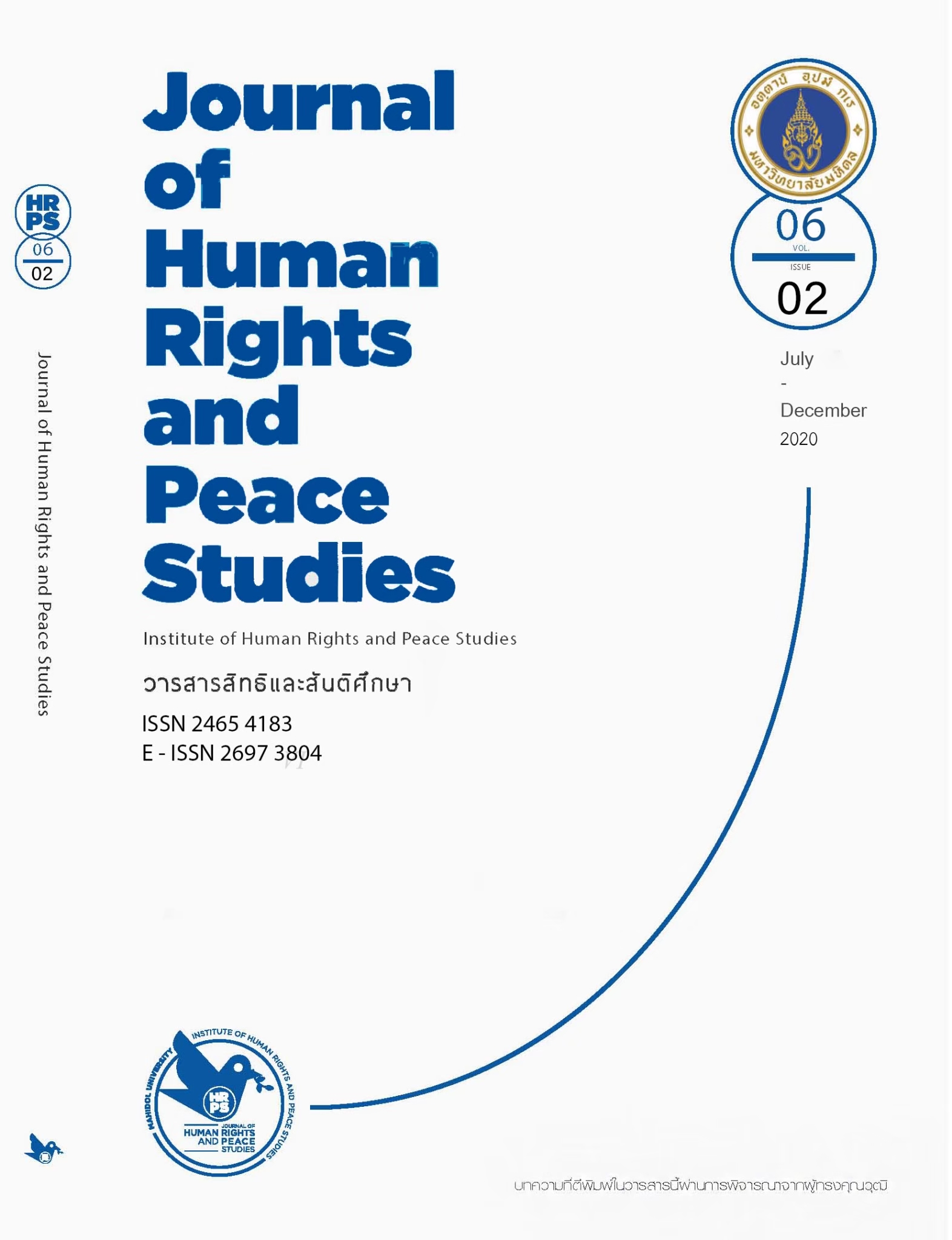Perceptions of Participants, Who Attended the Development Gender and Intersectionality Lens Training Workshop
Main Article Content
Abstract
In working to promote gender justice, a gender lens alone is not sufficient to understand inequity; rather adopting an intersectional approach has proven to be necessary. This study employed a descriptive research approach to explain perceptions of and changes among participants who attended a gender and intersectionality lens development training programme.Twenty-two participants from 13 organisations took part in this research study. Data was collected using a structured questionnaire and in-depth interview. Descriptive statistics and content analysis were used to analyse data. The findings of the research revealed that all participants were satisfied with the programme contents and training approach with an average satisfaction score of 3.55 out of 4. According to the interview data, most participants reported that an experiential learning approach and diversity of participants helped them realise and better understand the sources of injustice. They were able to apply knowledge to make changes in their work. Nevertheless, in order to apply knowledge to create changes at an organizational level, participants must have a role in decision making and participating organizations need to engage in policies that support social justice.
Article Details

This work is licensed under a Creative Commons Attribution-NonCommercial-NoDerivatives 4.0 International License.
The views, opinions, and pictures expressed in this journal are those of the authors and do not necessarily reflect the opinions and viewpoints of the editor and the editorial board. All rights are reserved by the authors and the Institute of Human Rights and Peace Studies of Mahidol University. No part of this journal may be reproduced, stored in a retrieval system, or transmitted in any form or by any means without the prior permission in writing from the journal’s editor, or as expressly permitted by law, or under terms agreed with the appropriate reprographics rights organization. Non-commercial use of information in this journal must be properly referenced.
References
Archavanitkul, K.,& Wajanasara, K. (2015). Mō̜ng phān lēn phēt phāwa læ khwāmlāklāi: Kh ō̜sanœ̄ kānphatthanā yutthasāt phư̄a suk phāwa phūying[Gender and diversity lens: Recommendations on strategy development for women’s wellbeing]. Sexuality Studies Association.(in Thai).
Asdornnithee, S. (Ed.). (2009). Chitta panyāsưksā khư̄ʻarai[What is contemplative education?]. Contemplative Education Center, Mahidol University. (in Thai).
Bell, L. A. (2007). Theoretical foundations for social justice education. In M. Adams, L. A. Bell, & P. Griffin (Eds.), Teaching for diversity and social justice (2nd ed.). Routledge.
Celik, H., Abma, T. A., Klinge, I., & Widdershoven, G. A. M. (2012). Process evaluation of a diversity training program: The value of a mixed method strategy. Evaluation and Program Planning, 35(1), 54-65. https://doi.org/10.1016/j.evalprogplan.2011.07.001
Conwill, W. L. (2010). Domestic violence among the black poor: Intersectionality and social justice. International Journal for the Advancement of Counseling, 32, 31-45. https://doi.org/10.1007/s10447-009-9087-z
Dean, L., Tolhurst, R., Khanna, R., & Jehan, K. (2017). ‘You’re disabled, why did you have sex in the first place?’ An intersectional analysis of experiences of disabled women with regard to their sexual and reproductive health and rights in Gujarat State, India. Global Health Action,10(sup2), 33-42. https://doi.org/10.1080/16549716.2017.1290316
Eseryel, D. (2002). Approaches to evaluation of training: Theory and practice.Educational Technology & Society, 5(2), 93-98. https://www.jstor.org/stable/jeductechsoci.5.2.93
European Institute for Gender Equality. (2016). Gender equality training: Gender mainstreaming toolkit.https://eige.europa.eu/gender-mainstreaming/toolkits/gender-equality-training
Haider, H. (2017, April 11). Changing gender and social norms, attitudes, and behaviours. Institute of Development Studies. https://www.ids.ac.uk/publications/changing-gender-and-social-norms-attitudes-and-behaviours/
Hankivsky, O. (2012). The lexicon of mainstreaming equality: Gender based analysis (GBA), gender and diversity analysis (GDA) and intersectionality based analysis (IBA).
Canadian Political Service Review, 6(2- 3), 171-183. https://ojs.unbc.ca/index.php/cpsr/article/view/278
Ivancevich, J. M., & Gilbert, J. A. (2000). Diversity management: Time for a new approach. Public Personal Management, 29(1), 75-92.https://doi.org/10.1177/009102600002900106
Kelleher, D. (2009, November 5). Action learning for gender equality: The gender at work experiences. Gender at work. https://genderatwork.org/wp-content/uploads/2017/10/Action-Learning-for -Gender-Equality.pdf
Khuankaew. O. (2012).Sēnthāng sū kān plīanplǣng: Phēt læ khwāmpen tham bon thān čhit winyān læ kānrīanrū dūai hūačhai[Path to change: Sexuality and justice based on spirituality and contemplative education.Foundation for Women. (in Thai).
Kolb, A. Y., & Kolb, D. A. (2005). Learning styles and learning spaces: Enhancing experiential learning in higher education. Academy of Management Learning & Education, 4(2), 193-212. https://www.jstor.org/stable/40214287
Lee-Gosselin, H., Brier, S., & Ann, H. (2013). Resistances to gender mainstreaming in organizations: Toward a new approach. Gender in Management, 28(8): 468-485. https://doi.org/10.1108/GM-10-2012-0081
Lombardo, E., & Agustin, L. R. (2011). Framing gender intersections in the European Union: What implications for the quality of intersectionality in policies?. Social Politics, 19(4),
Office of Women's Affairs and Family Development. (2008). Kān songsœ̄m khwāmsamœ̄phāk ying chāi nai nūaingān phāk rat khō̜ng samnakngān kitčhakān sattrī læ sathāban khrō̜pkhrūa [Promotion of gender equality in state agencies by the Office of Women’s Affairs and Family Development]. http://www.dcy.go.th/woman_man/data/278.pdf. (in Thai).
Office of Women's Affairs and Family Development. (2013). Sarup rāingān kān ngānk ān songsœ̄m khwāmsamœ̄phāk ying chāi nai rabop rātchakān pra pīsō̜ngphanhārō̜ihāsiphok [Summary report of operation on gender equality of government sectors]. http://www.dcy.go.th/woman_man/data/2710.pdf (in Thai).
Phanit, W.(2015). Rīanrū sū kān plīanplǣng[Transformative Learning]. The Siam Commercial Foundation. (in Thai).
Ringheim, K., & Colombini, M. (2010). Evaluation of the WHO training initiative transforming health systems: Gender and rights in reproductive health 1997-2007: Executivesummary. World Health Organization. https://apps.who.int/iris/bitstream/handle/10665/70203/WHO_RHR_10.04_eng.pdf;jsessionid=DE4CB97AF5C5FC93A4BAE0391818D4A0?sequence=1
Rosenthal, L. (2016). Incorporating intersectionality into psychology: An opportunity to promote social justice and equity.American Psychologist, 71(6), 474–485. https://doi.org/10.1037/a0040323
Sakulhuong, K. (2019, December 17). Radap khwām thaothīam thāng phēt thūa lōk Thai yūtrong nai khō̜ng phǣnthī lōk [Global gender equality level: Where is Thailand?]. The Standard. https://thestandard.co/global-gender-gap-index-2020-2/ (in Thai).
United Nations Entity for Gender Equality and the Empowerment of Women. (2012). Using CEDAW and UN Security Council resolutions on women, peace, and security to advance gender equality. https://trainingcentre.unwomen.org/pluginfile.php/2485/mod_resource/content/1/Using%20CEDAW%20and%20UNSCR%20for%20Advancing%20GE%20training%20manual%20eng.pdf
World Bank Group. (2018). Kānmī sūanrūam thāng sētthakit khō̜ng klum LGBTI nai prathēt Thai [Report on economic participation of LGBTI Groups in Thailand]. http://documents.worldbank.org/curated/en/319291524720667423/pdf/124554-v2-main-report-Economic-Inclusion-of-LGBTI-Groups-in- Thailand-Report-Thai-Version-PUBLIC.pdf (in Thai).


